
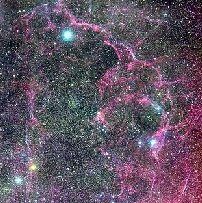
|
Bill Blair's
Vela Supernova Remnant File
|

|
Photo credit (left): Color optical image showing the filaments north of the
pulsar (see below).
Credit and copyright: David Malin and AAO.
Photo credit (right): Wide field X-ray image.
Rosat Observatory, NASA
Go to the
Hubble Heritage page about the Pencil Nebula (photo released June 5, 2003).

Welcome! This site provides some background about the Vela supernova remnant (SNR),
a roughly 11,000 year old leftover from a supernova explosion in our Milky Way
galaxy. This object is about 250 parsec (815 light years) away in the
constellation of Vela (which represents the sail of the mythical Argonaut's
ship). This distance makes the Vela SNR one of the closest SNRs to the solar system.
Our appreciation and understanding of this interesting object have changed
dramatically over the last decade. The SNR has been recognized as such for decades,
with a non-thermal radio source (characteristic of SNRs) and selected optical
filaments showing indications of heating by fast shock waves from the supernova.
A pulsar (spinning neutron star) has also been known since the early 1970's,
and is thought to represent the collapsed core of the star that exploded. It is
from the so-called "spin down rate" of this pulsar that the estimate of 11,000
years since the supernova has been derived, although most astronomers would not
claim this number to be more accurate than a factor of two (either way).
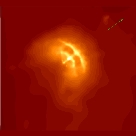 Caption: The region right around the Vela pulsar, as viewed in X-rays by the
Chandra X-ray Observatory. The region shown here is so small that it would be barely
visible in the wide angle X-ray image shown in the next figure. The pulsar is
moving toward the upper right in this picture. See
THIS SITE
for more information.
Caption: The region right around the Vela pulsar, as viewed in X-rays by the
Chandra X-ray Observatory. The region shown here is so small that it would be barely
visible in the wide angle X-ray image shown in the next figure. The pulsar is
moving toward the upper right in this picture. See
THIS SITE
for more information.
The full extent of the expanding remnant was not known until the mid-1990's when
a sensitive X-ray image of the region was obtained with the
Rosat satellite.
This image is reproduced below.
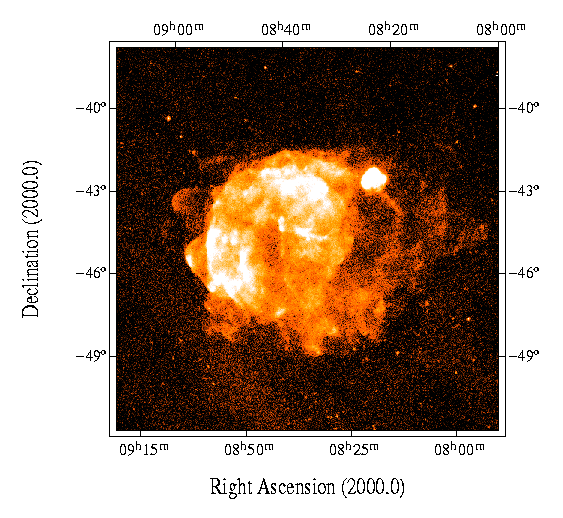
Caption: This Rosat All-Sky Survey image was the first to show the full extent
of the Vela SNR (from Aschenbach et al. 1995, Nature, 373, 587). Before this, only the
inner bright, roughly circular region had been ascribed to the SNR. The bright clump
of emission near 8h20m, -43 is a separate background SNR known as Puppis A.
You should note the angular scale on this figure: the full extent of the SNR
on the sky is about
8 degrees! For reference, the full moon is about a half degree across,
so this is some 16 times the angular size of the moon!
Prior to this, only the inner bright ring (about 4 degrees across) had been
identified in radio and X-ray observations. An interesting sidelight of this
discovery was that it solved a long standing mystery. The Vela pulsar should
have been close to the center of the SNR, but was off to one side of the
bright 4-degree section. Now that the full extent is seen, it turns out
that the pulsar is indeed close to the center!
In the optical, it is more difficult to separate out the emission due to
the Vela SNR from other emitting regions along the line of sight. Here is
as very wide field image in the light of the red hydrogen alpha emission line:
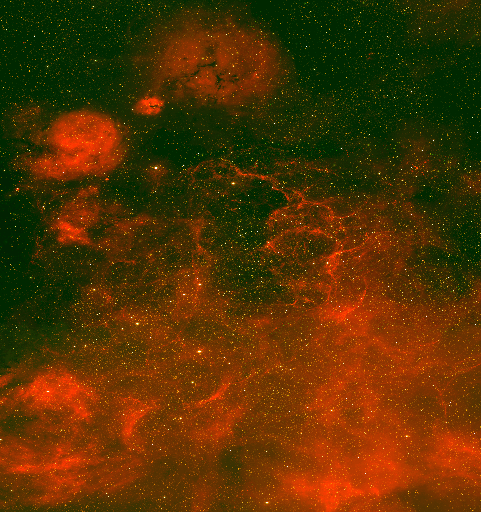
Caption: This very wide field Hydrogen-alpha image is from the
Royal Observatory's SuperCOSMOS Halpha Survey project, centered
on the Vela SNR. Only the filaments slightly above and right of center are
obviously associated with the SNR itself. Nearly everything else is
foreground or background emission.
Here is another nice image of the optical emission, provided to me by
astrophotographer Bert Van Donkelaar:
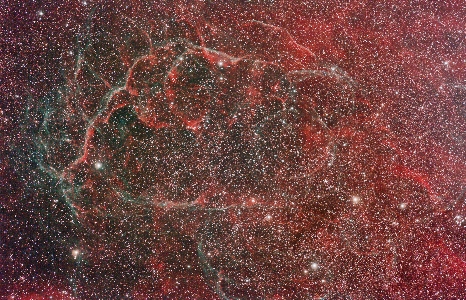
Caption: In this "image", Bert has actually stitched together multiple images in multiple
filters to make a single, color-composite image. He used a Canon 300mm f/2.8 lens
mounted on the side of a guide telescope. Red shows the light of the hydrogen Balmer-alpha
line and the blue picks up the [O III] 5007 Angstrom (ionized gas) line.
More on Bert's photography can be found
HERE!
(Click image to see larger version. For a high-quality JPG of this image,
GO HERE. For a wider FOV of the region, also by Bert,
GO HERE.)
To put these images in context relative to each other, here is a figure that
overlays the H-alpha and X-ray wavebands. (This has been done only in an approximate
manner, for illustrative purposes only!) The X-ray is shown in blue/green
with the optical remaining in red.
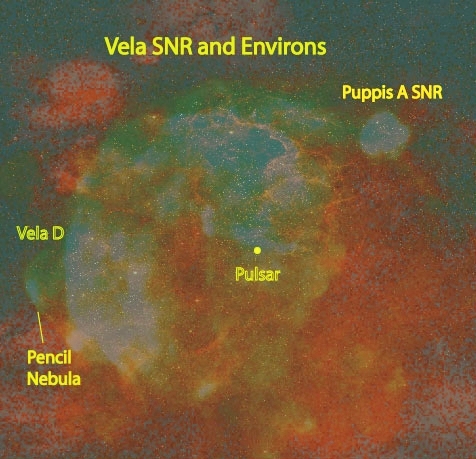
This is a bit messy, but hopefully you can see how the bright X-ray region
north of the pulsar is bounded by the optical filaments. The bright X-ray
blob to the NW (upper right) is actually a separate supernova remnant,
Puppis A, which is much farther away (about 2000 parsecs, or 6500 light
years) in the next spiral arm out in this direction).
The other region marked on the figure above is called "Vela D" or sometimes
"Knot D." In the Rosat X-ray picture above, you can see a number of protruding
regions outside the main shell of X-ray emission. In the discovery paper,
Aschenbach et al. (1995, Nature, 373, 587) labelled these protrusions with letters,
and the naming convention took hold. Here is a figure that shows this
naming convention.
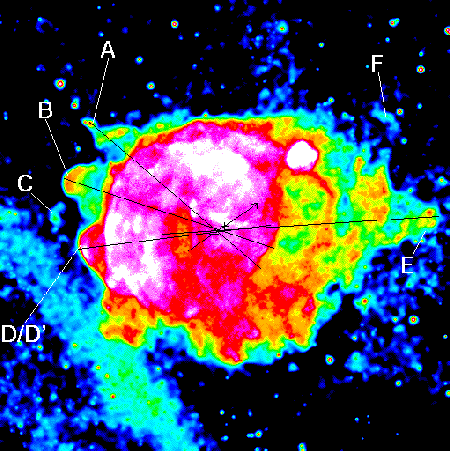
The Vela Knot D region is interesting, and my colleagues Ravi Sankrit, John
Raymond and I have recently published a paper
on the ultraviolet emissions from this region (links to a pdf file).
The X-ray Knot D is bounded by a beautiful "fan" of optical filaments
know commonly as the Pencil Nebula (NGC 2736), the subject of
a June 2003 Hubble Heritage photo release. This image is centered near the region
observed in the ultraviolet spectral region in our paper. See below for some additional
notes about the Field of view images by the Hubble Telescope.
Briefly, when first discovered the Knot D region (as well as the other
protrusions seen in X-rays) was thought to represent
a place where "ejecta" (chunks of the precursor star) were being shot out
at high velocity from the explosion site. However, even with extensive observations
of the region, it has been difficult to confirm (or refute!) this claim. The
ultraviolet and optical observations are consistent with the region being a
"breakout" from the main shell of the SNR. That is, a weaker, lower density
portion of the shell may have allowed the main shock wave to "run ahead" in
this region, and the shock wave is now encountering a denser region again, causing
the X-ray and optical/UV emission we see. We do not find evidence for
peculiar abundances or physical conditions that would indicate stellar
ejecta are involved in creating this structure Future observations, including
some with the
Chandra X-ray Observatory,
are being pursued to reconcile which of these models might be correct.
One final surprise discovered fairly recently is that yet another supernova
remnant is present along this line of sight! When the Rosat X-ray data shown above
were processed in a way that showed only the higher energy X-rays, a separate, smaller
diameter shell popped out:

Caption: These two images show low (left) and high (right) energy X-ray images
of the same piece of sky (from
Aschenbach, B. 1998, Nature, 396, 141).
In the right panel, a separate supernova remnant, about 2 degrees across, is revealed.
The distance to this new supernova remnant (known formally as RX J0852.0-4622, but
known affectionately as "Vela Jr.") is a matter of hot debate. It could be a
background object, similar to the Puppis A SNR mentioned above. A more tantalizing
possibility, though, is that it is physically associated with the Vela SNR, and
represents an even younger supernova from within the same generation of stars! The
discovery image above even raises the possibility that the Vela D/Pencil Nebula
region could be associated with THIS OBJECT instead of the Vela SNR itself.
It's amazing sometimes how surprises pop out of new observations, and how
difficult is can be to discern the true situation!
Further Notes about the Hubble Heritage Image Released June 5, 2003

The Hubble Space Telescope image
of the Pencil Nebula region is an excellent demonstration of Hubble's ability to
resolve fine scale structure. But by comparing to the images above, you should also
realize that the field imaged with Hubble is a tiny portion of a MUCH larger object!
It is important to remember that what we see as a flat image is
really a 3-dimensional structure in space, in particular extending
into the screen (or page) as well as across it. (Astronomers
say it extends "along the line of sight".) On the large scale,
the Pencil nebula appears to be an example of where the
supernova blast wave (or shock front), moving from right to
left in the picture, is encountering a region of enhanced
density in the interstellar medium. Think of the blast wave
as a sheet in the wind (perhaps a sail?), rippling along the
line of sight. Where ripples in the sheet become
tangent to our sight line, we see sharper edges or brighter
regions, and where the sheet is less edge-on, we see more diffuse
or clumpy emission (and generally fainter). The HST picture shows
us this process in glorious detail, showing that the spatial
scales of these ripples extend to finer scales than can be seen
from the ground.
Now what about the differences in the red and blue emission in the
picture? The blue comes from [O III] 5007, and the red from
(primarily) H-alpha (with perhaps some [N II] 6584 mixing in.
Never mind the differences in "elements", in this case. What we
are really seeing is changes in ionization of the gas. Just think
of the blue stuff as being "hotter" than the red stuff.
Think of a SN shock wave as an "impulsive" heating mechanism: the
shock wave hits a clump of gas and heats it up, but then the clump
is free to cool down (by emitting the light that we see). This
is different than heating by starlight (photoionization), where the
star keeping pumping in energy over a period of time. In the
HST picture, the regions in blue have cooled to the point where
the hotter [O III] emission line is strong, but they have not
cooled to where they can emit in H-alpha (and/or [N II]).
The red regions have cooled beyond the point where the hotter
[O III] emission is dominant, and the other lines pick up and
become bright. Then, of course, because of the aforementioned
line of sight effects ("projection effects"), there are places
where the situation appears more confused.
One of the neat things in the HST picture is the variety of
scales over which we see this phenomenon occurring. On the
large scale (and remembering that the shock wave's motion is
directed toward the left), fluffy wisps of blue filaments
lead the entire structure. But then in the regions "behind"
the brightest filaments (again in projection anyway, toward
the right in the picture), one sees many lovely examples of
where this process is occurring on much smaller spatial scales,
that is, where a blue filament lies directly on the leading edge
(left side) of a group of red filaments.
One last thing I'll mention is that there are some small, brighter
"clumps" of emission scattered about the picture. Brightness
comes from one of two things: either higher local density of gas or
more gas projected locally along a given line of sight (or a
combination of the two). It is not always possible to distinguish
between these two possibilities (at least without a spectrum),
although given the general patchiness or clumpiness observed,
one can imagine that the interstellar gas being encountered by
the SN shock wave is itself somewhat clumpy.
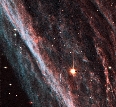 Go to Hubble Heritage Page on the Pencil Nebula (June 2003 release).
Go to Hubble Heritage Page on the Pencil Nebula (June 2003 release).
-- Bill Blair
Last updated: Apr. 5, 2009

Go to Ravi Sankrit's home page, or
Go to Bill Blair's home page, or
send mail to Bill Blair.










